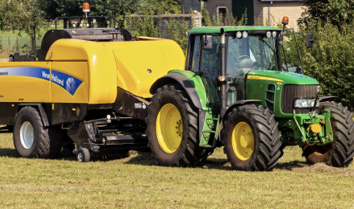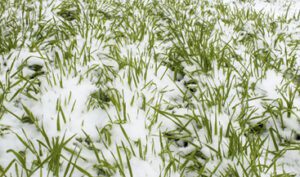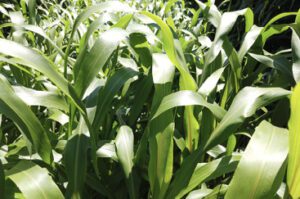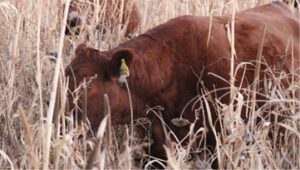
In the Beef Science class I took in college, the instructor put a “break-even” up on the board, totaling all the various costs of raising a beef calf to weaning. Feed cost (80% of total) was at the top of the list and the vast majority of the cost revolved around providing hay or silage for winter feed which are expensive because they require mechanical harvesting. That was true in the 1980’s and it is even more exaggerated now. Mechanical harvest requires machinery and fuel, and we all know what has happened to those costs recently. We so often do what we do out of habit, rather than making conscious decisions. In 1973, fat cattle were selling for $0.50 a pound, and you could buy a newly invented big round hay baler for $3000, so 6000# of steers would buy a new baler. Today fat calves are bringing $1.25 a pound, but a new baler costs $55,000, so now it takes 44,000# of cattle to buy a new baler, or seven times as much as in 1973. The economics of making hay have gotten progressively worse and worse, but just as a frog in the pan of water on a stove that is gradually brought to a boil won’t jump out, we keep right on making hay year after year, even when the economics no longer make sense.
Of course, animals still need fed in winter. But it doesn’t necessarily require feeding hay or silage. Here are some ideas on how to eliminate the need for hay or silage from your livestock operation:
1) More Acres Add grazing acres during the winter by using cover crops on cropland. Forage growth requires sunlight and favorable temperatures, which are most abundant in the late spring and early summer. Traditionally, we just started feeding hay when the pasture forage ran out. But we can also simply add more acres by planting winter cover crops on cropland and move animals onto these acres during the winter after crop harvest. Some cover crops like winter rye can make considerable growth even when temperatures are only slightly above freezing. Since the cost of these acres has usually been borne by the grain crop, the grazing on these acres often costs only what the cost of the seed and planting cost and are thus very low cost.

2) Stockpile forages One of the most empowering ideas I have ever learned in forage management is that “the grazing season is not limited to the growing season”. Some forages retain their quality into the winter while others do not. The absolute best stockpiled forage where it is adapted is tall fescue, particularly novel endophyte varieties that do not produce the toxins found in the widespread Kentucky 31 tall fescue. The quality of tall fescue can be quite good even in midwinter, but fescue is a perennial and many people would prefer a stockpiled forage that can be grown within a crop rotation. (Though the profitability of a good stand of perennials can compete with grain crops; see the article in this guide entitled “Bet you feel stupid now”.) One such option is a non-grain producing forage sorghum, which has a waxy coating on the leaves that make it resistant to winter weathering and can produce very high yields. Unless the goal is to actually fatten animals on grain, a grain producing hybrid is undesirable because ruminant animals that consume too much grain often develop acidosis. There are three broad traits in sorghum that prevent grain production. The first is photoperiod sensitivity, in which the plant does not begin to flower until daylength drops below a certain length, usually 12 hours and 20 minutes, in which case there is not sufficient time before frost for grain to develop.

Photo By: GW Seed
Photoperiod sensitive plants tend to be very high yielding and drought tolerant, but often get very tall and sometimes lodge, and their quality might not be quite as good as other packages. A second trait is male sterility, in which case the pollen is incapable of fertilizing the female parts of the plant. Just FYI, if there are male fertile (regular seed producing hybrids of sorghum, shattercane or even Johnsongrass) sorghums in the field, then male sterile hybrids can produce grain. Male sterile hybrids usually have excellent palatability, because when there is no developing seed to fill after flowering, the sugars produced by the plant simply accumulate in the stalk, making for a very sweet plant with palatable stalks. The third approach is to simply plant a very long maturity hybrid later in the season, too late for grain to ripen. This is an approach I prefer when double cropping a stockpiled sorghum after wheat harvest; I really like the long maturity, dwarf brown midrib forage sorghum as it stands well, yields great, is inexpensive to plant, and has great forage quality. But if planted too early, it can produce huge amounts of grain and risk acidosis with direct grazing.
3) Set yourself up for stockpiling success. One other concept that I have discovered to be highly useful is that “you cant graze in winter what you already grazed off in the fall”. So, for example, tall fescue is an excellent winter grazing resource, but if animals are simply left on it all summer and fall then there is nothing left to graze in winter. So providing alternate grazing resources during summer and fall can allow the fescue to be rested in summer (when the forage quality is poor and the endophyte toxicity is high) or in fall and be available to use in winter when it is better than just about any other grazing option. I had a conversation with a farmer last summer at a farm show, he was asking for a recommendation for a sudangrass for baling. I told him my favorite sudangrass hybrid for haying, and then asked a few more questions. It turns out he had an adjacent pasture composed of nearly pure tall fescue. I asked him why he didn’t graze the sudangrass in the summer and stockpile the fescue for winter grazing. He looked at me like I had a third eyeball in the middle of my forehead, and said “Naw, I can use my fescue in summer and I need the sudangrass for hay in the winter.” That, folks, is like using a Ferrari to pull a plow and a tractor to drive to town. If he had used the sudangrass for pasture for the months of July and August and September, he could have put likely an extra 100 pounds of weight on his calves and improved his breeding percentages because sudangrass is a far superior summer forage than fescue. He would also allow his fescue enough growth over those 90 days or so that he could graze far into the winter with same fescue acres, and not have to feed hay. Doesn’t it make sense that three months of rest in the summer could add three more months of grazing at the end of the season? He could also drill rye into the grazed off sudan, and graze that rye in the winter as well for even more hay savings. Best of all, he could skip all the time, expense, and aggravation of making hay out of the sudan. We are talking about the same exact acres of land, but with far better animal performance and far less cost.

Winter grazing of summer planted warm season mixes can be very successful and save tons of hay. When done properly, the nutritional needs of the cattle will be met through the majority of the late fall and winter.
Photo By: Brett Peshek
4) Always have a plan B. Even with the best laid plans, it is still good to have some hay on hand, because things never work out exactly like you plan. Hay on hand is peace of mind. But just like planning on collecting crop insurance is a really bad business plan, a livestock feeding plan with no alternative other than feeding hay for half the year is also a bad business plan. Have hay on hand, but don’t just feed it because you made it and want to justify the effort. Try to have every month covered with a grazing resource, possibly more than one, and keep hay as a last resort.
If you have ruminant livestock, there is probably no other practice that will improve your profitability more than reducing the amount of mechanically harvested feed that your animals require.
Pull Out Box
We also recommend reading the great book by our friend Jim Gerrish Kick the Hay Habit: A Practical Guide to Year-Around Grazing
This article first appeared in the 8th Edition of Green Cover's Soil Health Resource Guide.
Also check out the 10th edition, our latest Soil Health Resource Guide, over 90 pages packed with scientific articles and fascinating stories from soil health experts, researchers, farmers, innovators, and more! All as our complimentary gift to you, a fellow soil health enthusiast!
